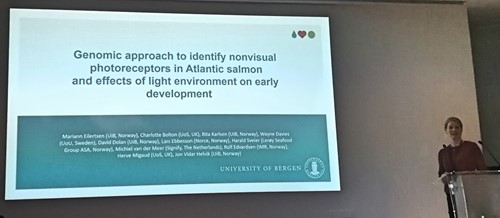Report from the International Conference on Integrative Salmonid Biology
Charlotte Bolton is a PhD student at the Institute of Aquaculture, University of Stirling. SAIC sponsored her attendance at the 4th International Conference on Integrative Salmonid Biology (ICISB 2019) in Edinburgh, 18-20 November 2019 to present a poster of her work. This is her report:
The theme ‘Beyond the genome: taking leaps forward in salmonid biology’ reflects greatly upon the astounding progress made in genomic resource development and its utilisation to further salmonid biology on an international scale since the Atlantic salmon reference genome was published in 2016. This conference was a great platform for members of the international research community and industrial partners to display the breadth of current genome-enabled research. Showcasing its application across a diverse range of topics including: conservation, ecology, evolution and physiological, alongside addressing key concerns for salmonid aquaculture such as sea lice and the effects of global warming on salmonid populations and production implications.
I was given the opportunity to present a poster on work from my PhD at the Institute of Aquaculture, University of Stirling in collaboration with the University of Bergen titled ‘Clock genes and circadian rhythmicity in Atlantic salmon’. In addition, I contributed towards my University of Bergen collaborator Mariann Eilertsen’s, presentation ‘Genomic approach to identify nonvisual photoreceptors in Atlantic salmon and effects of light environment on early development’, in which published salmonid reference genomes have been fundamental to our work. This has enabled us to start exploring the effects of narrow bandwidth LED light on photoreception, clock gene expression and circadian rhythmicity in early developmental Atlantic salmon.


Conference highlights
The plenary presentation by Ben Koop, University of Victoria was a fascinating insight into the Functional Annotation of All Salmonid Genomes (FAASG) and the progress of the project to date. Identifying fundamental areas such as nomenclature at a chromosomal and gene level across salmonid species, require consolidation to aid a widespread understanding. A series of six presentations from researchers at the Institute of Marine Research, Norway emphasised the applicability of genomics and genome editing technology across a vast range of topics to provide potential solutions for key concerns in salmonid aquaculture. Simen Sandve, Norwegian University of Life Sciences gave a thought provoking presentation on gene regulatory expression in salmonids and stated “present-day salmonids have retained 50-60% of duplicated genes from the salmonid genome duplication event (Ss4R)”. Expanding on issues caused by whole genome duplication events Camille Berthelot, Institut de Biologie De l’Ecole Supérieure stated that duplicate misidentification in gene trees is common, and proposed a synteny based method to resolve the misidentifications for which the pipeline will soon be made available. A technique that may prove valuable in my work when aligning clock gene duplicates in a number of salmonid species. The imminent release of the brown trout (Salmo trutta) reference genome as part of the Wellcome Sanger 25 Genome Project will enable me to add another salmonid species to this alignment.
This conference has not only highlighted the progress of work on salmonid reference genomes, but the importance of communication and collaboration within the wider salmonid scientific community. It has also provided an invaluable link to established academics and industry partners - bringing together a wealth of information, guidance and providing inspiration for the next generation of researchers through networking.
Apply for a SAIC travel grant
Share this